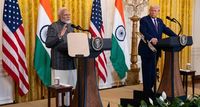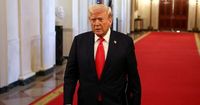In a significant move that could reshape international trade dynamics, three top copper suppliers to the United States—Canada, Chile, and Peru—have firmly asserted that their copper imports do not pose a threat to U.S. security interests. This statement comes in response to President Donald Trump’s administration, which initiated a probe into potential tariffs on copper imports under the Section 232 national security provision of the Trade Expansion Act of 1962. This law was previously utilized by Trump to impose a 25% tariff on steel and aluminum.
According to data from Trade Data Monitor (TDM), these three countries collectively account for an impressive 94% of U.S. imports of refined copper and copper alloys. Chile leads the pack, providing 70% of these imports, followed by Canada at 17% and Peru at 7%. All three nations enjoy free trade agreements with the U.S., which they argue are crucial for maintaining economic stability and security.
In a letter dated March 31, 2025, Chile’s ambassador to the U.S., Juan Valdes, emphasized the importance of copper imports from his country for U.S. supply chain security, stating, “Copper imports from Chile contribute to the United States’ supply chain security and do not represent any risk to its national security interests.” This sentiment was echoed by Canada’s government, which highlighted that maintaining free trade for copper supports U.S. security efforts, particularly as the metal is integral to defense industries.
Pierre Gratton, president of Canada’s Mining Association, voiced concerns that imposing tariffs on Canadian copper would be “counterproductive.” He argued that such measures could inadvertently bolster China’s position in the global copper market, as the American Chamber of Commerce in Chile pointed out that tariffs could make Chilean copper exports more appealing to China, thereby undermining U.S. economic interests.
In a related development, a letter from Peru’s foreign trade ministry urged the U.S. to exclude Peru from any potential restrictions, asserting that its copper imports pose no security risks. “We trust that our longstanding and reliable trade relationship will continue… thereby allowing our exports to continue,” the letter stated.
As the Trump administration navigates these complex trade waters, it is also facing challenges from other nations, particularly India, which has adopted a non-confrontational approach to U.S. tariff threats. On April 2, 2025, the Trump administration imposed a hefty 26% tariff on imports from India, alongside similar tariffs on numerous other trading partners. However, these tariffs were paused for 90 days on April 9, although a lower 10% blanket tariff remains in effect for India and most other nations.
In anticipation of these tariffs, New Delhi proactively reduced tariffs on various U.S. products, including Harley-Davidson motorcycles and bourbon whiskey, and offered to cut duties on over half of its U.S. imports valued at $23 billion. In 2024, India’s bilateral trade with the U.S. reached a staggering $129 billion.
Despite these efforts, certain sectors in India remain vulnerable to U.S. tariffs, particularly gems and jewelry, marine products, electronics, and auto parts. The Trump administration has raised concerns about India’s high tariffs on historically protected sectors like agriculture, as well as non-tariff barriers such as import bans and licensing requirements.
Since liberalizing its economy in 1991, India has gradually reduced its average tariff from 78.85% in 1990 to 12.28% in 2023. However, it still heavily protects sectors like agriculture and automobiles, which could complicate future trade negotiations. Indian Foreign Minister S. Jaishankar has emphasized that India’s “real opportunity is with Western markets where we can grow exports.”
Looking ahead, India and the U.S. are negotiating the first phase of a bilateral trade agreement aimed at increasing bilateral trade to $500 billion by 2030. This deal, expected to be finalized by fall 2025, will focus on enhancing market access and reducing tariff and non-tariff barriers.
Meanwhile, Canada risks falling behind as the U.S., U.K., European Union, and New Zealand make strides toward sealing free trade deals with India. Without a free trade agreement, Canadian exports to India are subject to the same tariffs as those applied to other World Trade Organization members. This has raised concerns for key Canadian exports, such as lentils, which were recently subject to a 10% tariff after previously enjoying duty-free access.
As the global trade landscape evolves, the impacts of tariffs are felt far and wide. In China, for example, small businesses are grappling with the fallout from Trump’s tariffs, which have reached as high as 145% on all Chinese goods bound for the U.S. Lionel Xu, a small business owner, lamented, “This is so hard for us,” as his products sit idle in warehouses due to the prohibitive costs imposed by tariffs.
Despite these challenges, some Chinese businesses are looking to diversify their markets, with some companies seeking opportunities in Europe and the Middle East. However, the overarching sentiment remains one of uncertainty as the trade war continues to unfold.
As the U.S. tourism industry also braces for impact, recent data indicates a decline in international arrivals, with visits from overseas dropping by 11.6% in March 2025 compared to the previous year. The Las Vegas Visitors and Convention Authority has projected a 5% decline in room tax revenue, a trend that could reflect the broader effects of Trump’s trade disputes.
In conclusion, as the U.S. navigates these complex trade relationships, the implications of tariffs and trade agreements will continue to reverberate across global markets, affecting everything from copper supplies to tourism and small businesses worldwide. The coming months will be critical for all involved as negotiations progress and the economic landscape shifts.





